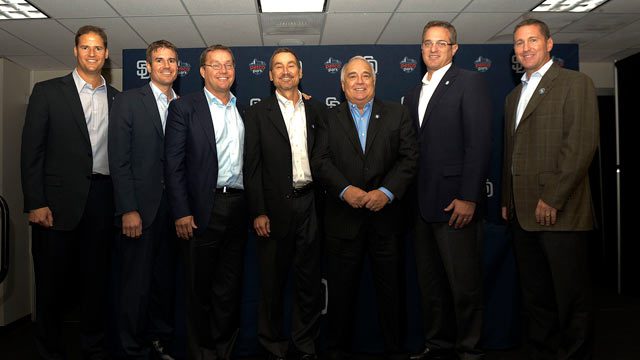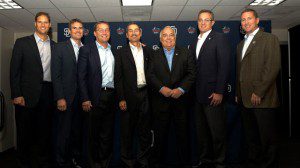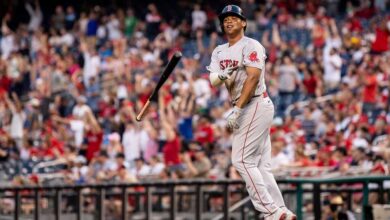

After being swept by the Colorado Rockies last weekend, the San Diego Padres were off to the second worst start in franchise history at 2-10. Not the best of starts for the new ownership group that includes Peter O’Malley’s sons, Kevin and Brian, and nephews Peter and Tom Seidler. The team is headed by San Diego businessman Ron Fowler, the executive chairman. General manager Josh Byrnes was retained in his role, so this begs the question of who’s responsible for the poor start. Is it Brynes or the new ownership team?
After a solid finish to 2012, Brynes’ only key free-agent signing was veteran starting pitcher Jason Marquis. The Padres were outspoken about needing two pitchers, yet they only re-signed Marquis, now 34, who went 6-7 last year as a Padre with a pedestrian 4.04 ERA — a guy who probably wouldn’t crack most teams’ starting rotation. Still, I liked the signing for veteran presence and depth on depleted pitching staff due to injuries. However, as time went on, it was disappointing to see Byrnes do so little.
Let’s take a look at some of the moves under Josh Byrnes in his tenure with the Padres:
- I like most of Byrnes’ moves, however, the Anthony Rizzo and Andrew Cashner trade is an exception.
- I loved the Mat Latos trade, which brought over San Diego Padres first baseman Yonder Alonso, catching prospect Yasmani Grandal, Brad Boxberger, and starting pitcher Edinson Volquez. Even with the Grandal’s PED suspension to begin the 2013 season, I absolutely would have pulled the trigger on that deal. The San Diego Padres used their pitching resources to acquire talent for an organization starving for offensive production, so there’s no way the Padres could turn it down.
- I liked the under-the-radar trade for promising pitcher Tyson Ross along with infielder A.J. Kirby-Jones. The Padres gave up utility infielder Andy Parrino and journeyman pitcher Andrew Warner for Ross, who has so much raw ability.
- The San Diego Padres also traded minor-league pitcher Simon Castro and Pedro Hernandez for outfielder Carlos Quentin in attempt to protect Chase Headley. We saw how that helped Headley last year, despite Quentin’s inability to play every day. (Note: I wouldn’t have extended Quentin for three years, even though the cost was relatively cheap compared to the production per game of other comparable players.)
- Byrnes also acquired proven closer Huston Street without giving up much in minor-league left-hander Nick Schmidt.
- Getting Marquis off the scrap heap with all the injuries last year was a good move, but I would not have re-signed him to a major-league deal.
- Byrnes’ claim of Eric Stults from the White Sox for just a roster spot was a good move. Stults went 8-3 last year in 14 starts with a 2.90 ERA, while having more success (surprisingly) away from spacious PETCO Park.
- Acquiring catcher John Baker from the Marlins for starter/swing-man Wade LeBlanc added depth at a weak position (at the time).
- I love the trade that sent reliever Ernesto Frieri for the Angels sinker-ball starting pitcher Donn Roach and infielder Alexi Amarista. We should see Roach sometime this year.
- I liked the move for veteran leadership presence in Mark Kotsay, something I believe the Padres lacked in 2011. It’s a minor move, but a good one in my book.
Overall, I think Byrnes has done a fine job, and I don’t think he, manager Bud Black or team president Tom Garfinkel’s jobs are in jeopardy this year. These guys can only work with what they’re given, and with their resources, I think they’ve done a fine job.
Still, more could have been done. Was Byrnes so naive to believe the San Diego Padres could compete by standing pat or was ownership being cheap? I tend to believe that if Byrnes could have made some baseball and business savvy moves, he would have, given the lack of immediate depth in the Padres system due to injuries to key players. I mean, this is the guy who traded Latos to bolster the offense, which was a bold move for such a controllable young and talented player.
I kept waiting for a move during the offseason because of the needs spoken about by ownership and the GM, but then the Winter Meetings came and went, and spring training started … and nothing. There were myriad pitchers the Padres were linked to, some who seemed to have injury question marks, which the San Diego Padres desperately need to avoid. However, the fact they wanted two pitchers, possibly three, and ended up with Marquis and a currently struggling Ross, is somewhat alarming.
The facts is we don’t know much about the new regime, because they haven’t been vocal, and they’ve been around for less than a year. The new ownership did make some considerable changes, most notably the new dimensions at PETCO Park. The changes are not overly dramatic and will undoubtedly bring in revenue, as well, with the additional seats installed.
I believe this was a wise move by ownership, something the previous regime was against. The change should create some excitement for fans, instill more confidence in the offense, boost the new TV deal with FOX Sports San Diego and eliminate some of the psychological elements position players face during 81 home games in such an extreme environment. I also believe this change will put more emphasis on the talent on the field, as opposed to letting the park dictate how the game is played, and it should expose pitchers who are PETCO aided, as well as attract some free-agent bats. I give the ownership a big thumbs-up for this; it was long overdue.
So, was the new ownership’s “splash” intended to make improvements to the park but not the roster? If you’re going to bring in the fences, the back-end-of-the-rotation pitchers who have benefited from the conditions in PETCO will be exposed. The old dimensions allowed ownership to use lower-tier pitchers and speed/contact hitters instead of a balanced roster. The San Diego Padres can no longer rely on the park as an aid for pitchers because of how PETCO now plays.
As a small-market team, the San Diego Padres can’t expect fan optimism to continue if the new front office continues the history of failed top draft picks and star players lost to free agency or traded due to lack of funds. This new group needs to right the ship. If this Padres ownership group believes bringing in the fences is the sole cure, they’ll soon discover that a status quo roster will deliver unsatisfactory results. It’s not that the San Diego Padres should spend money just to spend money. You could make the case that maybe, with so many current injuries, this year might not be the right time to go all-in, especially with Grandal out until late May, and injuries to key players and starting pitching prospects. With that said, you cannot solely rely on in-house unproven prospects, regardless of how highly their prospect status is touted. It’s naive to fill the void strictly from within and not make any notable trades or signings to upgrade the team.
The San Diego Padres ownership has stated a strong commitment to keeping homegrown star players. Yet, the Padres have not extended Headley’s contract yet. I believe the Padres ownership needs to make a statement by signing him. Headley is still on the DL, and the Padres would like to see if Headley’s MVP-like production continues. This is not as black and white as people may think. On one hand, you want to lock up your best player, the face of the franchise, to appease fans and then show a commitment to improving the team around him vs. breaking it down every year. You also don’t want to overpay a player who basically had three awesome months of baseball compared to his very solid play since he broke into the majors in 2007. Which Chase Headley will the San Diego Padres get? An All-Star or a very good MLB player? So, I understand ownership’s hesitation to sign him until they feel they know what they’re paying for.
While it’s very early in the San Diego Padres new ownership tenure, and I believe they’ve done positive things, they have a long way to go to entice fans to the park. A good next step would be to make smarter decisions and invest in a team filled with question marks, injuries and borderline talent.




